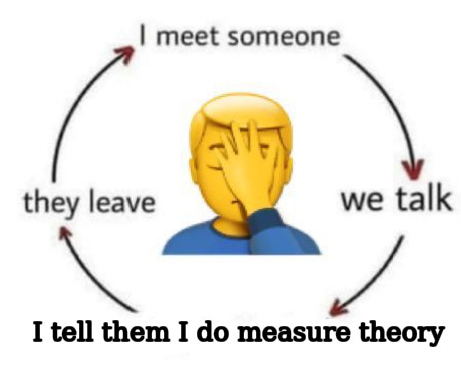What is Measure Theory, and How does it Affect Me?
Abstract
In this talk I will aim to provide a crash-course overview of the key concepts behind measure theory, focusing on the construction of the Lebesgue measure. This measure is the one that we all use each day without knowing it - it tells us that the area of a circle is πr2, and justifies the existence of rulers. At the end of this talk everyone will (hopefully) leave with an understanding of how measure theory permeates into other areas of mathematics, and an introductory understanding to the theory as a whole.
The reaction I usually get when I tell people my PhD concerns a large amount of measure theory can be summarised fairly well by the following diagram:

Whilst having an intricate knowledge of the ins and outs of measure theory is by no means a requirement for many applications of maths in the real world; it does secretly underpin a lot of the more familiar (and friendly!) things that we use in applied maths, and probability. • Have you ever wondered why PDFs are such a big deal when working in probability? • Have you ever used FEM or Fourier transforms to solve a problem? • Have you ever tried to break up a chocolate bar, and then reassemble the pieces into two chocolate bars of equal size to the first????
Disclaimer: I will be limiting the technical details to the bare minimum I need, and will include diagrams and analogies wherever possible. I’m also not going to be assuming any prior knowledge of measure theory, so anyone should be able to follow along even if they’ve never seen, never heard, or have actively avoided this topic before. It is not my intention to give a technical analysis talk at 10:15 in the morning, no-one wants that, not even me!